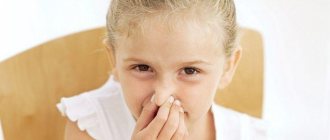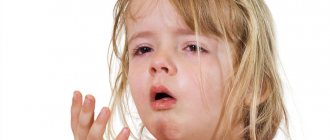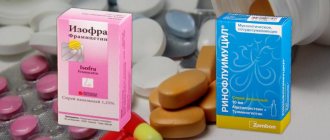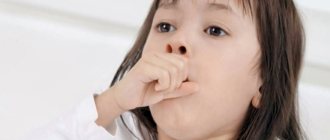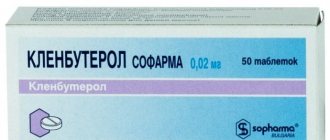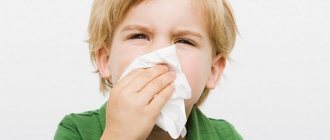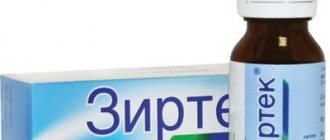Rhinosinusitis is an inflammation of the mucous membrane that affects the paranasal sinuses . In this case, one or more sinuses are affected. The canals that connect the sinuses to the nasal passages become swollen and inflamed. This leads to the accumulation of mucus and pus there. When rhinosinusitis occurs, correct treatment is required, which must be prescribed by a doctor. Symptoms and treatment of rhinosinusitis in children should also only be assessed by a qualified specialist.
Rhinosinusitis occurs in a child due to a bacterial infection entering the nasal passages during ARVI. Children aged 5 years and older often suffer from ARVI, so it is important to pay attention to signs of pathology. But, in addition to a respiratory infection, rhinosinusitis can be provoked by injuries to the nose, in which there is a displacement of its structures, regular manifestation of swelling of the nasal passages due to allergies, and hypertrophied adenoids. There is also a possibility of such a manifestation with various anomalies in the structure of the nasal passages, etc.
Children often suffer from this disease, since the maxillary sinuses are formed during the first 7 years of life. The anatomy of children's noses also affects the incidence of rhinosinusitis in children. The passages and canals of the sinuses are very narrow, and even slight swelling provokes their closure. Rhinosinusitis is diagnosed in 30% of children.
Rhinosinusitis in a child can last quite a long time - up to 40 days . With correct treatment, relief will be felt within 7 days. For children, this period can increase to 10 days. If after this time there is no relief, then a more thorough diagnosis is prescribed. Bacterial culture of the contents of the nasal sinuses is mandatory.
Symptoms
It is typical for rhinosinusitis that its manifestations begin after 7-10 days. The symptoms are similar to infectious diseases, which arose as a primary pathology. The main features include:
- Complete or partial nasal congestion, which is accompanied by discomfort.
- Severe headache, from which even analgesics often do not help.
- Increased body temperature.
- Nasal discharge. They have a thick consistency, and the color can be white, yellow-green or even brown .
- Impaired sense of smell.
- Cough, which is explained by the flow of mucus down the back wall of the nasopharynx.
- Painful sensations that are localized in the cheek area, as well as above the eyebrows.
How does the disease develop?
A prolonged runny nose is the beginning of the disease. The symptoms are as follows:
- The timbre of the voice changes, it becomes muffled, low, creating the feeling that it is difficult for the child to pronounce words.
- There is obvious nasal congestion and problems with breathing.
- The sense of smell decreases. The decrease may be permanent or return periodically.
- Body temperature rises.
- Headaches appear, they are not pronounced, but unpleasant, nagging, which do not go away, but make themselves felt throughout the day.
- There is a feeling of heaviness in the area above the eyebrows. This causes significant discomfort, many people compare it to the sensation of having foreign bodies under the skin.
- Nasal discharge is opaque and has a yellowish, greenish or brown tint.
- The child loses interest in games, activity, even eating. He looks depressed, and even during sleep the long-awaited relaxation does not occur. The child often wakes up at night, in the morning he does not feel relief, and does not look rested.
Factors contributing to the development of the disease
Deformation of the lateral wall of the nose is a factor that triggers the disease. As a result, the secretion stagnates; due to the anomaly, it does not come out, so the sinuses always remain full.
There is another reason: fungi and bacteria that multiply in the sinuses. The reasons are bronchial asthma, allergic rhinitis, which contributes to the appearance of the disease and weak immunity, which can be undermined as a result of frequent illnesses and taking medications.
Forms and stages of rhinosinusitis
Experts distinguish the following stages: acute, subacute, chronic, recurrent. The acute stage means the onset of symptoms that persist for 30 days. Subacute stage means symptoms persist for up to three months. If we talk about the recurrent stage, then there is a periodic repetition of the acute period, but if the symptoms are observed for more than 3 months, then it can be stated that they have become chronic.
Important points to consider when discussing forms of rhinosinusitis:
- Ethmoiditis is a form that involves an inflammatory process in the ethmoid sinuses.
- Sinusitis is a form with inflammation of the sinuses in the maxillary part.
- Frontitis - the frontal sinuses become inflamed.
- Sphenoiditis - the process of inflammation occurs in the sphenoid sinuses.
Rhinosinusitis often affects different types of sinuses; it can be bilateral or unilateral. In catarrhal rhinosinusitis, significant swelling of the mucous membrane appears, but the secretion does not come out. Purulent rhinosinusitis is a significant accumulation of purulent masses in the sinuses, which extremely worsens the child’s well-being and contributes to the appearance of pronounced headaches.
The main danger of the disease
Without proper treatment and diagnosis, rhinosinusitis develops into a chronic form, which worsens the general condition, reduces hearing, sense of smell, and this is not all the consequences. It is necessary to immediately contact a specialist, diagnose, identify the stage or condition of the baby, it is necessary to identify the form of the disease, which will allow you to immediately begin effective treatment.
Acute rhinosinusitis
Acute rhinosinusitis in childhood is characterized by the manifestation of pronounced signs of the disease. The first symptoms will be the child's lethargy and headache . Then the body temperature rises to 39 0C or more. Acute rhinosinusitis in children is also manifested by swelling of the face - in the area of the nose, forehead and eyelids. In addition, with acute rhinosinusitis, the child becomes capricious and sleeps poorly.
During an acute process, bacteria actively multiply, which means that they spread to neighboring sinuses. If the inflammatory process has spread to both sides, the manifestation is more pronounced and the treatment will take longer.
Acute rhinosinusitis can be divided into several types:
- purulent;
- catarrhal
Acute purulent rhinosinusitis in children is characterized by an inflammatory process in the sinuses and anastomosis. At the same time, as a result of the activation of bacteria, pus accumulates in the paranasal sinuses, the anastomosis is swollen, which makes it difficult for it to exit. The main symptoms will be fever up to 40 0C, severe headache and in the face. With acute purulent rhinosinusitis, children may experience toothache or ear pain. There may also be pain in the eyes and back of the head if the child leans forward.
Purulent rhinosinusitis in children is divided into several types, this division depends on the localization of the inflammatory process. Its types are sinusitis (damage to the maxillary sinuses), frontal sinusitis (damage to the frontal sinuses), ethmoiditis (inflammation of the ethmoid sinuses), sphenoiditis (pus collects in the sphenoid sinus). The symptoms are also similar, only the pain is localized in different places. With sinusitis, pain occurs in the cheek area, and it intensifies when turning the head; in a calm state, the child may complain of discomfort in the cheeks. Frontal sinusitis is characterized by pain in the forehead, and with ethmoiditis, a nasal voice is also added. Inflammation of the sphenoid sinus is manifested by dull pain that dissipates.
Acute catarrhal rhinosinusitis is characterized by severe swelling . First, the inflammation is localized in the nasal passages, and then affects the sinuses. The symptoms of this rhinosinusitis are less pronounced, and the manifestations are similar to a common runny nose during a cold. Quite often, when this stage occurs, there is no nasal discharge at all. Characteristic symptoms for catarrhal rhonasinusitis are lacrimation, burning sensation and frequent dryness in the nose. The child will also complain of headaches and parents may experience sleep disturbances.
Rhinosinusitis in children symptoms Komarovsky
Rhinosinusitis: types, symptoms, treatment
The content of the article
Rhinosinusitis is a collective term that describes a group of acute or chronic inflammatory processes occurring in the paranasal sinuses and nasal cavity. According to statistics, rhinosinusitis is diagnosed in approximately 5% of patients visiting a doctor. Moreover, in 0.5% of cases of respiratory viral infections, a complication occurs with a bacterial form of the disease.
As a preliminary diagnosis, before conducting a full examination of the nasal cavity, ENT specialists, as a rule, indicate rhinosinusitis in the patient’s card. After clarifying the localization of the inflammatory process, the diagnosis is transformed into one of the following options:
- sinusitis (inflammation of the maxillary or maxillary sinus)
- ethmoiditis (damage to the ethmoid labyrinth)
- frontal sinusitis (frontal sinus infection)
- sphenoiditis (inflammation of the sphenoid or main sinus)
- pansinusitis (affects all sinuses)
- hemisinusitis (unilateral damage to several sinuses).
- for complications
- for chronic polypous rhinosinusitis
- with acute purulent pansinusitis.
- oral medications
- antiallergic nasal drops
- saline solutions for rinsing the nasal passages (sea water or hypertonic sodium chloride solution)
- steroid drugs, which are used in the form of metered sprays, in accordance with the instructions for use.
- swelling of the mucous membrane
- pain near the sinuses
- mucus secretion or dripping down the throat
- severe headaches.
- the cause is eliminated (pathogenic pathogens, allergens)
- natural outflow of mucus is resumed
- immunity is restored and maintained.
Types of rhinosinusitis
Taking into account the fact that each type of rhinosinusitis disease has fairly clear symptoms, medical practice has established parameters for their classification. An accurate determination of the nature of this disease allows the doctor to select the most optimal treatment tactics for each individual patient, taking into account the age category and general health condition.
One of the most common pathologies of the nasal cavity is inflammation of the upper respiratory tract - rhinosinusitis. This disease most often occurs in children, pregnant women and people with weak immune defenses.
According to the flow time
Depending on the duration of the period during which inflammation in the nasal cavity is observed, rhinosinusitis is divided into two main groups:
In most cases, the inflammatory process of the nasal cavity and paranasal sinuses lasts no more than ten days. Moreover, if acute rhinosinusitis occurs more than three times in adults or children over the course of a year, this indicates a recurrent nature of the disease.
Treatment of acute rhinosinusitis is often based on antibiotic therapy. The likelihood of surgical intervention occurs in the following situations:
Chronic rhinosinusitis may indicate pathology of the nasal cavity, as well as the paranasal sinuses: its symptoms are similar to the acute course of the disease, only this form of the disease lasts for several months.
Based on the development mechanism that characterizes chronic vasomotor rhinosinusitis, treatment, first of all, involves restoring the functioning of intranasal structures and their normal structure.
Due to the occurrence
Depending on the causes of rhinosinusitis, doctors identify several key types of this disease. Each of them has its own distinctive features and, therefore, a specific approach to treatment.
Vasomotor rhinosinusitis
Chronic inflammation of the inner mucous membrane of the nasal cavity, which is accompanied by a runny nose and nasal congestion, is called vasomotor rhinitis. Treatment in this case can be medicinal and surgical.
Drug treatment is based on the following medications:
In some cases, the otolaryngologist may also recommend to the patient the installation of intracervical blockades (performed using novocaine), injections of steroid drugs, and acupuncture.
Infectious rhinosinusitis
Inflammation of the inner lining of the nasal cavity caused by viruses or bacteria is called infectious rhinosinusitis. The predisposing factor for this form of the disease is allergies and impaired immune function of the body.
Rhinosinusitis in children most often occurs due to infection with a respiratory viral infection: influenza microorganisms, parainfluenza, adenoviruses, rhinoviruses and similar pathogenic flora.
The course of infectious rhinosinusitis largely depends on the age of the patient. In 85-98% of cases, patients are prescribed medication. It is aimed at improving the process of drainage from the sinuses in order to prevent surgical intervention.
Polypous rhinosinusitis
Polypous rhinosinusitis manifests symptoms in the form of constant nasal congestion. This form of the disease is chronic. It is characterized by the formation and subsequent recurrent growth of polyps. In most cases, treatment for polypous rhinosinusitis involves surgery, medication, or a combination of these methods.
Conservative treatment of polypous rhinosinusitis consists of prescribing glucocorticosteroid drugs, which quickly have an anti-inflammatory and immunosuppressive effect. Moreover, the main problem of this disease is the high probability of re-formation of polyps after surgery.
Allergic rhinosinusitis
Allergic rhinosinusitis often precedes respiratory diseases, and can occur in parallel with them. The allergic form of the disease manifests itself in the sensation of itching and burning in the nasal cavity, frequent bouts of sneezing and the presence of nasal discharge.
When a diagnosis of allergic rhinosinusitis is made, treatment is prescribed after determining the type of irritant. Only in this case can a sustainable effect be achieved and the occurrence of cross-allergosis (interaction of the allergen with the immune system) avoided.
It is important for everyone to have an idea of what allergic rhinosinusitis is: the symptoms and treatment of this disease, methods of prevention and recovery procedures, as they are somewhat different from the treatment of other forms of rhinosinusitis.
Symptoms indicating rhinosinusitis
Everyone would like to know what symptoms accompany rhinosinusitis: treatment will be prescribed depending on the severity of certain symptoms. Moreover, different age groups are characterized by a certain localization of the inflammatory process in the sinuses.
The main indicator of rhinosinusitis is difficulty breathing. Moreover, depending on the causes and course of the disease, general symptoms may be supplemented by specific ones. This will help to correctly determine how to treat rhinosinusitis in order to avoid complications and relapses.
Common symptoms of rhinosinusitis, regardless of the nature and stage of the disease, are:
Features of the treatment of rhinosinusitis in children
In most cases, rhinosinusitis in children manifests symptoms quite clearly, which allows the doctor to accurately diagnose the disease and begin therapy immediately. Usually, to cope with this disease, complex treatment is prescribed, aimed at achieving an effective and, most importantly, sustainable result. To do this, using special medications, the following basic steps are performed:
Along with modern drugs, treatment with folk remedies is used for the diagnosis of rhinosinusitis. The most effective and efficient medicine is considered to be calendula ointment, as well as a decoction of oak bark (20 grams of bark per glass of water), which is used to dip turundulas to insert into the nasal passages.
When rhinosinusitis is detected in children, treatment is often carried out using medicinal herbs. However, such therapy is, as a rule, auxiliary in nature, so the possibility of their use should be consulted with a specialist.
In any case, the main thing is not to miss the first symptoms of inflammation of the nasal cavity. And for this it is important to understand what rhinosinusitis is, to know its types and features. Moreover, the course of treatment should be started only after visiting a doctor. This is what will help quickly eliminate the disease and avoid complications.
Return to number
Effective treatment of rhinosinusitis in children
Authors: Katrin BIEBACH, Adelheid KRAMER
Upper respiratory tract infections are considered the most common diseases of childhood. Preschool children experience 5-7 upper respiratory tract infections per year [1]. Infections of the nasopharynx and oropharynx are the most common reason for visiting a pediatrician, general practitioner or ENT doctor. As a rule, these diseases are accompanied by the development of acute rhinosinusitis due to the narrower anatomical dimensions of the nose and paranasal sinuses in children.
Epidemiology and pathogenesis
The most common cause of acute rhinosinusitis is a viral infection (adenoviruses, rhinoviruses, influenza and parainfluenza viruses). In this case, bacterial superinfection (Streptococcus pneumoniae, Haemophilus influenzae, Moraxella catarrhalis) is also possible [2].
Numerous studies have demonstrated that when acute rhinosinusitis lasts up to 7 days, bacterial infection is usually verified in 20% of cases [3], while before the fourth week - in 35% of cases [4]. According to Neumann, the reason for this is a viral infection and a decrease in the lumen of the anastomosis of the paranasal sinuses due to inflammatory edema, which leads to a deterioration in their ventilation and drainage, accumulation of secretion, a change in its composition and a decrease in pH in the paranasal sinuses [5].
Clinical symptoms and differential diagnosis
A review by Wald [6] suggests the following criteria for differential diagnosis between acute viral and acute bacterial rhinosinusitis:
- in most cases, the duration of uncomplicated viral rhinosinusitis is 5-7 days
- if the disease lasts from 10 to 30 days, there is no positive dynamics, despite symptomatic therapy, bacterial rhinosinusitis should be suspected
- the presence of fever and purulent nasal secretions for 3-4 days also indicates a secondary bacterial infection. Children complain of headaches in the facial part of the skull, pain around the orbits, and periorbital edema may be observed [6].
It should be noted that in young children the only symptom may be a cough.
Treatment
Numerous studies in both children and adults show that early administration of antibiotics is not superior to placebo in either symptom relief or the prevention of complications [7, 9]. New scientific data obtained in recent years and an increase in the number of antibiotic-resistant strains of pathogens require the development of new strategies for the treatment of acute rhinosinusitis, especially in pediatrics [7, 10, 11].
The primary goal of treating rhinosinusitis is to restore secretion drainage and ventilation of the paranasal sinuses.
There is convincing data regarding the treatment of acute rhinosinusitis in adults with Sinupret, which should be supplemented by experience of clinical use in children.
Purpose of non-invasive research
The herbal preparation Sinupret has been used in Germany for more than 70 years and has been used in other countries for 30 years. The drug is indicated for the treatment of acute and chronic sinusitis in children and adults. The 5 medicinal plants it contains (Gentiana lutea, Primula veris, Rumex acetosa, Sambucus nigra, Verbena officinalis) have demonstrated a wide range of pharmacological effects on symptoms characteristic of rhinosinusitis in various studies [13, 14]. Pharmacological, toxicological and clinical studies of the drug Sinupret, as well as many years of experience in its clinical use, give grounds to conclude that it is highly effective and safe in the treatment of acute rhinosinusitis in adults [15]. To obtain more detailed data on the effectiveness and safety of the drug in children with sinusitis, a multicenter non-invasive clinical study was conducted.
Methodology
The study was conducted from March 2002 to September 2003 in 967 medical centers in Germany (pediatricians, general practitioners, ENT doctors). The results of treatment of 3109 children, whose average age was 6.9 years, with symptoms of rhinosinusitis were analyzed. The distribution of patients by age and gender is shown in Table. 1.
Two thirds of children (64%) received Sinupret drops in an age-specific dosage 3 times a day. One third - mostly children of the older age group - received Sinupret tablets one tablet 3 times a day.
The primary study was carried out before the start of treatment (interval t0), the control visit (t1) - 6 days later, the final study (t2) - after 12 days.
During the study, the dynamics of the following symptoms were documented:
- headaches and facial pain
- nasopharyngeal secretion
- difficulty breathing through the nose
- hoarseness
- cough.
A statistical analysis of the dynamics of these symptoms during treatment was carried out, and a general assessment of the effectiveness and tolerability of the drug Sinupret was given.
Concomitant treatment
At the start of the study, 74.2% of children were taking concomitant treatment: rhinological drugs (43.8%) and antibiotics (14.8%).
results
The most common recorded symptoms before treatment (t0) were nasopharyngeal secretion and difficulty in nasal breathing. Almost all children reported more (67%) or less (33%) viscous (83%) or watery (17%) consistency of nasopharyngeal secretion; 71% of children described the secretion as colored and only 29% as colorless. Nasal congestion occurred in 98% of children of all age groups. The proportion of children with significant impairment of nasal breathing in both age groups was about 40%.
The second most common symptom was cough (88%). 60% of children in the younger age group and 57% in the older age group complained of severe and moderate cough. 62.5% of children in the younger and 83.5% of the older age groups reported headaches and pain in the facial area. About 68% of children complained of hoarseness, which in most cases was not pronounced.
Final inspection data
During the final examination, 93% of patients reported a small amount of nasopharyngeal secretion, the consistency of which in 90% was watery and transparent. At the end of treatment, only 0.3% of children experienced significant difficulty in nasal breathing. Less than 3% of patients continued to have moderate nasal congestion. With regard to cough, a clear positive trend was observed: at the end of the study, 75% of children had no cough, and 25% had a mild cough. At the end of treatment, 96% of children in the older age group and 92% of the younger age group had no headaches. Only 5% of children reported mild hoarseness (Table 2).
During the analysis of the effectiveness, Sinupret drops and Sinupret dragees demonstrated comparable effects. It has been shown that the analgesic effect of Sinupret drops for pain in the throat and facial area in children of the younger age group is more pronounced than when using Sinupret tablets.
Evaluation of efficacy and tolerability
In 88% of children of all age groups, effectiveness and tolerability were assessed as very good or good, in 7% - as average, in 4% there was no data on effectiveness.
A total of 25 cases of side effects (0.8%) were recorded, which were assessed as non-severe. These are mainly gastrointestinal disorders and skin rashes. In 50% of cases, researchers associated them with concomitant antibacterial treatment or an underlying disease.
Discussion
The effectiveness of treatment of acute rhinosinusitis in children with Sinupret was assessed as very high. This result was achieved in both age groups, regardless of the dosage form. The presented study confirms the high effectiveness and good tolerability of treatment with Sinupret.
conclusions
The first non-invasive study using the drug Sinupret in the treatment of acute rhinosinusitis in children confirmed the high effectiveness and tolerability of the herbal combination drug for acute sinusitis. The wide range of pharmacological effects of the drug Sinupret and the presence of two dosage forms (drops and tablets) make it the optimal treatment for the disease in children starting from two years of age.
Thus, this study confirmed the effectiveness and good tolerability of Sinupret in the treatment of acute rhinosinusitis in children.
Rhinosinusitis
What it is?
Rhinosinusitis is a complex disease in which the paranasal sinuses and the nasal mucosa are simultaneously affected by infection or viruses. As usual, the inflammatory process starts in the maxillary sinus and later moves to the main mucous protective structures.
Signs and symptoms
The main symptoms of rhinosinusitis usually include nasal congestion and significant difficulty breathing. Regardless of the degree and severity of the disease, the patient also experiences periodic headaches localized at the base of the nose, constant discharge of purulent secretion with its regular entry into the nasopharynx, as well as general swelling of the nasal mucosa.
Main types and forms of rhinosinusitis
The course and clinical pictures for different types of the above disease differ in particular cases:
Acute rhinosinusitis
The acute form of this type of disease is characterized by severe intoxication of the body, rapid and vivid manifestation of the symptoms described above. Within five to seven days after the onset of inflammatory processes, a person cannot lead a full life, his performance is significantly reduced, pain syndromes in the head become paroxysmal.
At the same time, body temperature almost always rises, often exceeding 39 degrees Celsius. Swelling of the mucous membranes can extend beyond the organ and spread to the eyelids and upper facial tissues. Pathogenic microflora actively multiply and occupy increasingly larger spaces, affecting neighboring sinuses and causing complications.
Chronic rhinosinusitis
This kind of inflammatory process is less pronounced when compared with the previous form of rhinosinusitis, but it is longer lasting and can often occur in a sluggish form from twelve to thirty weeks. The main symptoms of this condition are normal temperature, significant weakening of hearing and smell, constant moderate swelling of the mucous membranes with severe blockage of the nasal passages, as well as a nasal voice and mucopurulent secretion discharged from the nose.
Pain syndromes in this case appear much less frequently, they are “smeared out” and, if they occur regularly, cause a feeling of weakness and irritation.
In the chronic form of rhinosinusitis, the likelihood of getting a complication is much higher than in the case of an acute course of the disease.
Polypous rhinosinusitis
Further progression of chronic rhinosinusitis usually leads to the formation of polyps - active growth and thickening of the walls of the mucous membranes, as a result of which the swelling significantly increases in size, and vasoconstrictor drugs do not help to temporarily restore normal breathing. This condition is quite often accompanied by stagnation in the sinuses, a large amount of purulent masses, which further activate inflammatory processes in the body and form the basis for the development of associated complications, in particular deadly meningitis and tissue damage/eyeballs.
This type of rhinosinusitis can only be cured using surgical methods, mechanically removing polyps.
Allergic rhinosinusitis
The main cause of allergic rhinosinusitis and catarrhal, non-purulent course of the disease is the effect of allergens on the body. Such allergens can be plant pollen, wool, body reactions to certain medications, fungal spores, car smog and dust, etc.
The main symptom, directly indicating an allergic type of disease, is considered to be side rashes on the skin, significant redness of the membranes of the eyeball, itching in the nasopharynx, and copious clear discharge from the nose. Fighting allergic rhinosinusitis with antibiotics is useless; to effectively get rid of the problem, antihistamines and isolating the person/environment from the allergen are used.
Treatment of rhinosinusitis
Treatment of rhinosinusitis in adults is a complex process that includes eliminating the cause that caused the reaction, eliminating the source of inflammation, reducing symptoms, and restoring natural immune defenses.
- Antibacterial therapy with broad-spectrum antibiotics is the drugs Azithromycin or the alternative Augmentin. The duration of such a course does not exceed ten days
- Maximum removal of pathogenic secretions from the nose and sinuses. For this purpose, vasoconstrictor drugs (Naphthyzin), moisturizing and mucolytic drugs (Aquamaris), as well as means for draining and washing cavities (saline solution) are used.
- Reducing inflammation. For this, an ENT doctor may recommend corticosteroids (hydrocortisone) and antihistamines (Loratadine).
- Strengthening the immune system. It can be carried out both at the local level using special homeopathic sprays (IRS 19), and general procedures, including normalization of nutrition, taking interferon, and regular exercise.
Treatment of the disease in children
Rhinosinusitis in children is treated in a more gentle way, excluding the use of broad-spectrum antibiotics and glucocorticosteroids. In this case, it is rational to use local combined drops for the runny nose in children based on steroids/antibiotics (Isofra, Bioparox, Protargol), rinse the sinuses more often with saline solutions, do inhalations using a nebulizer using Borjomi, and strengthen the child’s immunity.
Only in the most extreme case, with a very advanced form of the disease and in case of direct danger to the baby’s life, is there a need to use classic “adult” drugs that have strong side effects and cause serious harm to the liver, kidneys and heart of your child.
Folk remedies
Folk remedies for rhinosinusitis, of course, are not a panacea for this disease, but they can really help you recover faster in the case of complex therapy with medications.
The most popular methods “from the people” are considered to be warming the nasal septum with hot salt in a bag, inhalation and instillation into the nose with herbal mixtures based on calendula, valerian, chamomile, eucalyptus and sage, as well as compresses based on tinctures of the same herbs. It should be understood that the above methods must be agreed with your doctor in order to prevent the condition from worsening and the occurrence of concomitant diseases.
Useful video
Have a quick recovery!
Sources: o-gaimorite.ru, www.mif-ua.com, www.doctorfm.ru
The following materials:
September 10, 2020
No comments yet!
Forms
Acute rhinosinusitis is divided into 3 main forms:
- light;
- moderate severity;
- heavy.
In mild forms, rhinosinusitis in a child occurs without high body temperature (does not exceed 37.5 0C) . At the same time, there are still no accumulations of mucus in the paranasal sinuses. With acute rhinosinusitis of moderate severity, the child will experience migraines, and pain in the cheeks and nose occurs only with pressure. The temperature at this stage is above 37.5 0C. There is mucus in the sinuses, and darkening will be visible on the X-ray image.
Severe rhinosinusitis is dangerous due to complications. The symptoms are pronounced - swelling of the eyelids and cheeks, weakness in the body. Body temperature reaches high levels, which further worsens the child’s well-being. An X-ray with severe rhinosinusitis will show complete darkening .
Symptoms of sinusitis
With an advanced runny nose or infectious lesion of the respiratory tract, the patient may be diagnosed with sinusitis, ethmoiditis or frontal sinusitis. Each disease occurs with a specific clinical picture. At the initial stage, the little patient is tormented by nasal congestion and the inability to breathe through the nasal passages. If a child aged three years and older can breathe through his mouth at this time, younger children do not have this function. Therefore, inflammation is accompanied by acute and painful symptoms.
Other symptoms include:
- temperature increase;
- severe congestion;
- accumulation of mucous secretion;
- purulent discharge;
- pressure between eyebrows;
- swelling of the cheeks and neck;
- pain in the head and temples;
- swelling of the mucous membrane;
- change in skin color;
- pain on palpation of the wings of the nose;
- weakness and fatigue;
- sleep disturbance;
- loss of appetite.
Remember! In addition to these signs, the baby may often touch the sore area, sleep on only one side, and also be very capricious.
It is dangerous to leave such symptoms unattended, so if your baby begins to complain of heavy discharge and pain in the forehead or nose, get examined by an ENT doctor.
Chronic rhinosinusitis
The chronic course of rhinosinusitis begins if there is no correct treatment for the acute form of the disease. In this case, the signs are less pronounced:
- persistent nasal congestion and impaired sense of smell;
- increase in body temperature to small levels from 37.0 0 to 37.5 0C, it increases more often in the evening;
- systemic headaches;
- scanty nasal discharge, sometimes completely absent;
- nasal voice;
- discomfort and heaviness in the area of the inflamed sinus;
- frequent lacrimation.
The chronic form of the disease manifests itself if the child’s acute rhinosinusitis is not treated correctly or the therapy is incomplete. Also, with curvatures and anomalies of the nasal septum, a chronic process and allergies and dental infections can develop .
Allergic and vasomotor rhinosinusitis
Signs of allergic-type rhinosinusitis quite often appear before ARVI, and they may also have a parallel course.
Symptoms of this type of rhinosinusitis include itching, a burning sensation in the nasal passages, and the child will often sneeze .
Nasal discharge is most often clear.
With allergic rhinosinusitis, it is important to determine which irritant provokes it. This is important when prescribing treatment.
Vasomotor rhinosinusitis quite often occurs in children aged 5 to 7 years . The reason for this condition is a decrease in the tone of the vessels that are located in the nose. A characteristic feature of this condition is the fact that the manifestations of the pathology change. This is affected by psycho-emotional stress, hypothermia, etc.
Treatment
Before prescribing drug therapy, appropriate diagnostics should be carried out. Rhinoscopy will be effective in this case . In this case, the doctor can assess the severity of swelling of the mucous membrane, as well as diffuse stagnation of hyperemia.
Anemization of the mucous membrane of the nasal passages is also carried out. This is done with adrenaline or oxymetazoline; after the procedure, pathological changes will decrease. Such procedures are performed extremely rarely on children.
They also do a nasal swab, but this method is ineffective. The most accurate study is a puncture from the inflamed sinus. In this case, the doctor will understand what the contents of the sinuses are. Children most often undergo endoscopic examination, since it is designed for narrow nasal passages, ultrasound and x-rays. In severe cases, a CT scan is required.
After a thorough diagnosis, the child will be prescribed treatment, which consists of several main aspects:
- nasal rinsing;
- anti-inflammatory drugs;
- antihistamine therapy;
- antibacterial therapy (prescribed to children in minimal doses);
- physiotherapeutic procedures and inhalations.
Causes of disease development in children
Let's take a closer look at one more, quite important point. We are talking about the reasons why children develop rhinosinusitis. This happens because ARVI is accompanied by a bacterial infection. The development of the disease in a child’s body is also facilitated by narrow nasal passages and the anatomical features of the structure of the olfactory organ, which make it difficult for the free outflow of pus.
Rhinosinusitis can also develop due to allergies or chronic diseases that reduce the body’s ability to resist viruses. Another reason is the entry of foreign bodies into the sinuses. The disease can also develop as a result of unsuccessful dental surgery. And, of course, childhood infections, among which scarlet fever, measles and chickenpox should be highlighted.
Therapeutic therapy for acute rhinosinusitis
If the disease is mild, then antibacterial drugs are not prescribed. All therapy includes restorative drugs. Children may additionally be prescribed folk remedies.
Already with manifestations of rhinosinusitis of moderate and severe forms, there are more drugs. It is imperative to use local medications, that is, vasoconstrictor drops and sprays . This is necessary to reduce the appearance of swelling of the mucous membrane and reduce nasal discharge. Such drugs are indicated for use for 5-7 days; after that, their use is prohibited, as they can provoke hypertrophy of the mucous membrane. And besides, dependence on these drops may occur.
Analgesics and antipyretics are also important. Since at this stage the child will have an increase in body temperature. For children, these drugs are prescribed in the form of syrups.
If acute rhinosinusitis is bacterial in nature, then prescribing antibiotics is a prerequisite. They are selected according to bacterial culture; it is important which pathogen provoked rhinosinusitis. There may be situations when antibiotics are prescribed before culture results are available. Therefore, the bacterium may be insensitive to this antibacterial substance:
- Most often, antibiotics of the penicillin or cephalosporin group are prescribed for rhinosinusitis. If the prescribed drug does not have the desired effect on the third day of treatment, it is replaced. Only a doctor should select all medications.
- If penicillins and cephalosporins are ineffective, macrolides may be prescribed . Such drugs are not recommended for use by children, as they negatively affect cartilage tissue, which is still developing. Therefore, they are prescribed extremely rarely before the age of 16.
Most often, antibacterial drugs are prescribed in the form of a solution for intramuscular administration, but for the treatment of children, drugs can be prescribed in the form of suspensions or tablets that dissolve in water.
A common symptom in children with rhinosinusitis is cough. Therefore, mucolytics may be prescribed. Additionally, antihistamines are needed; they help reduce swelling of the mucous membrane. And for allergic rhinosinusitis, they are simply necessary.
For any type of sinusitis, it is necessary to increase the child’s immunity. Doctors prescribe special medications for this. Inhalations for children will also be effective. Only a doctor will give recommendations on how and how much to use.
For rhinosinusitis, rinsing the nasal passages is recommended. For this, both salt water and a solution with furatsilin can be used.
UFO and UHF are also used. These procedures are used only at the recovery stage, that is, for recovery.
If a puncture is performed for purulent rhinosinusitis, the doctor first pumps out the pus from the sinus, and then rinses it. At the same time, an antiseptic solution is introduced. The puncture site heals quickly, within a few days, and there is no particular discomfort.
Treatment of rhinosinusitis in childhood
It is very important to carry out manipulations that allow the secretion to leave the paranasal sinuses and not stagnate in them. Cleaning should be carried out; physiological solutions used to wash the sinuses are especially effective in this. They reduce swelling, kill pathogenic microflora, and eliminate inflammation. Usually they use Marimer, Aquamaris.
Other solutions are also needed: Galazolin, Nazivin, Naphthyzin. They also kill pathogenic microflora, plus they constrict blood vessels, thus stopping the increased secretion production. Products based on phenylephrine have proven themselves well.
There are some other equally effective drugs. They are used for a course of no more than a week; drugs that have an antibiotic effect are also used, but their use is allowed only with permission and as prescribed by a doctor.
Therapy with medications has also proven successful: anti-inflammatory drugs like aspirin and paracetamol, which reduce pain and lower temperature. Antibiotics are often prescribed, as well as mucolytics, which discharge the secretion, make it more liquid and mobile, as a result of which it is more actively removed from the sinus.
And of course, it is important to maintain the child’s immunity, so doctors prescribe drugs that stimulate it. These can be ordinary medicinal herbal decoctions, pharmacological compounds.
Warming and rinsing the nose
Washing and warming are effective non-drug methods of exposure. Rinsing is carried out using a saline solution; it can be prepared at home. The composition is simple: three teaspoons of sea or regular salt per glass of warm water. They also make a solution with furatsilin; its tablets also dissolve well in water. Washing is necessary frequently, at least 3 times a day. Warming up involves staying in dry heat, but you need to exclude a high temperature in the child. If it is, then warming up is not suitable. Sometimes it is enough to apply special bags made of natural fabrics filled with warm dry sand or salt to the nose.
Manufacturers also produce lamps that emit blue light, which has a beneficial effect on well-being; they recommend exposure to light for 15 minutes. These lamps are sold everywhere, in almost all pharmacies.
Whatever the stage, the disease can be effectively treated if you approach the matter professionally and comprehensively. There is nothing wrong with combining different methods of influence: medications, including compositions with antibiotics, homeopathic remedies, heating with salt, sand and a lamp, strengthening the immune system, rinsing with solutions.
And of course, much attention is paid to the prevention of the disease in order to prevent its occurrence in the future. The problem is that many parents consider a runny nose to be a common illness that goes away on its own under the influence of the immune system. But the body of many people, and especially children, is very sensitive, especially since the child’s condition is often weakened due to unfavorable external influences: the environment, stress, increased workload at school, the presence of allergens, etc.
Complications
Complications of this disease occur when treatment was incorrect or absent altogether. The most common complication is the transition of the disease to a chronic form. And:
- the inflammatory process can spread to other structures - bronchi, lungs, ears . That is, due to the neglect of the process, bronchitis, otitis media or even pneumonia may occur;
- inflammation of the tissues of the eye sockets; even ulcers can occur in this location. As a result of this, visual acuity may decrease;
- meningitis, osteomyelitis and encephalitis;
- sepsis. In this case, the infection spreads throughout the body .
Such severe complications can be prevented if you consult a doctor in time. The child will be prescribed the correct treatment, after which relief will immediately come.
Treatment of sinusitis in children
Sinusitis in children is a serious disease, the treatment of which must be taken very seriously. Self-medication for sinusitis in children is strictly prohibited . At the first symptoms of sinusitis in your child, immediately consult a doctor for comprehensive treatment.
After confirming the diagnosis, the doctor will describe in detail how to treat childhood sinusitis depending on the stage and severity of the disease.
For effective treatment of sinusitis, make an appointment with the pediatricians of our Medical Center in Alexandrov by calling 8 (49244) 9-32-49.
Prevention
Children under 6 years of age often suffer from ARVI, and this becomes the main reason for the activation of rhinosinusitis. Therefore, it is important to carry out general prevention, that is, enhancing the child’s immune system. Preventive measures:
- Proper nutrition, enriched with vitamins and minerals.
- In spring and autumn, it is recommended to give your child multivitamin complexes.
- Any manifestations of a cold should be treated until complete recovery.
- The child should walk a lot and be physically active.
- Children are advised to regularly have their stool tested for worms, as parasites significantly reduce the body's defenses.
- Check your child regularly with a dentist, as infection in the nasopharynx can get from the oral cavity.
- If cases of influenza appear in a group in a kindergarten or school, then it is necessary to regularly rinse your nose with sea water sprays .
- If a child has allergies, then it is necessary to protect him from pathogens and carry out appropriate treatment so that the condition does not worsen.
Quite often, doctors give advice to parents: put aloe juice in the child’s nose; a small child can lubricate the nasal passages. This is good disease prevention.
